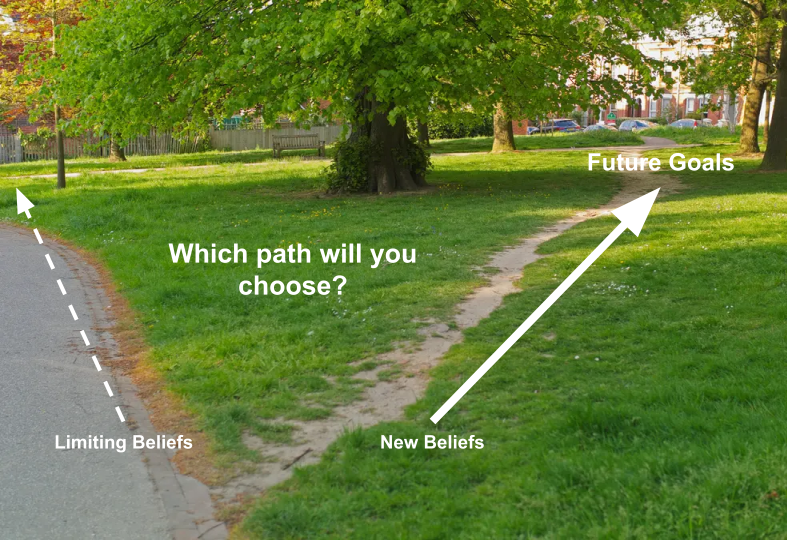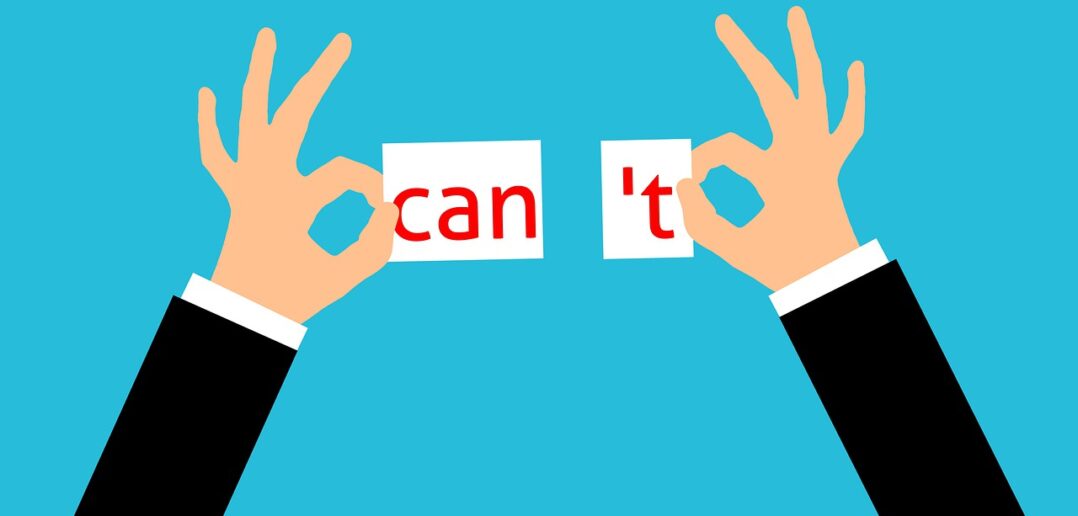At some point you’ve likely heard this famous quote from Henry Ford: “Whether you think you can or think you can’t, you’re right.”
This quote speaks to the power our thoughts have in shaping our reality and the actions we decide to take. Sometimes these thoughts provide incredible inspiration for growth, while other times they can sink us into a pit of despair.
It’s these more negative permutations of our thoughts that many of us struggle with the most. When we start to think thoughts that begin with…
- I can’t…
- I’ll never…
- I don’t have enough…
- I’m not…
It’s usually a sign that we are being held back by a limiting belief which is preventing us from reaching our goals.
Below I’m going to break down everything you need to know about limiting beliefs. What they are, how they form, how to identify them and what you can do to overcome them successfully.
Make sure you read until the end to find a Free Limiting Beliefs Journal you can download.
What Are Limiting Beliefs
To best understand what a limiting belief is, try imagining a baby elephant that is tied to a fence post at birth. When the baby elephant begins to explore its surroundings, their movement gets restricted by the fence post. As a result, the elephant starts to develop a slew of limiting beliefs about itself and the world around them:
- I can’t go there.
- I’m not strong enough to break free.
- I’ll never smell that tree.
Even as the elephant increases in size and strength, it continues to be limited by these beliefs. Any onlooker would clearly see how easy it would be for the elephant to break free, but the elephant stays put because it believes it can’t.
We all have these metaphorical fence posts and thoughts that are holding us back. Beliefs about ourselves and the world around us that we believe to be true.
Sometimes they’re trivial in nature like I can’t dance, but more serious cases sound like I’ll never find love or I’m not good enough. Negative thoughts that relentlessly attack our self-esteem, our choices and can have an ongoing negative impact on our Mental Health.
How Do Limiting Beliefs Form
A thought at its most basic level is a group of neurons in our brain communicating. This is illustrated by the popular phrase in neuroscience:
“Neurons that fire together, wire together.” – Donald Hebb
The more these neurons talk to each other (i.e. the more you think the same thought), the stronger their connection (i.e. neural pathway) becomes. Overtime they become ingrained as a belief and a preferred pattern of thinking.
Our brains love to create beliefs because they make “thinking” more efficient. Creating new neural pathways (i.e. thinking differently) is hard work, which means our brain typically opts for using well established beliefs and neural pathways instead.
Much like building a habit (patterns of action), as patterns of thinking develop (i.e. beliefs are formed), research has shown that our brain automatically starts to store these beliefs and thoughts in the primitive areas of our brain. When knowledge and beliefs are stored here, they move into our subconscious; which means we can have these thoughts without consciously being aware of them nor their impact.
For example, we may unintentionally sabotage a healthy relationship or fear cold calling because of a limiting belief in our subconscious telling us I’m not good enough.
Anxiety’s Role In Forming Limiting Beliefs
Anxiety plays an important role in forming these limiting beliefs because anxiety’s primary role is to keep us safe. This means brain activity will increase (i.e. faster thoughts) when it believes we’re in emotional or physical danger.
Increased brain activity means neurons in our brain are firing and wiring together at a quicker rate then normal. This is our brain trying to analyze, learn and remember detailed information about a threat at a rapid rate. The benefit of this is to help us overcome the present danger and learn how to avoid similar threats in the future.
For example, if you’ve ever been in a car accident or near death experience, you can probably remember these experiences in extreme detail years after they have occurred. During these traumatic experiences, neurons fired together and wired together so quickly and so intensely that your brain essentially said; we literally almost died and we’re never going to forget this.
In doing so, metaphorical fence posts and limiting beliefs get hammered into your brain like I’m unsafe in cars. These beliefs can also trigger easily in the future when environmental cues (i.e. getting into a car) look, sound, smell, feel and/or taste vaguely familiar to the original traumatic event.
Project Mamba: Stop Letting Stress Impact Your Commission Check
Chronic Stress And Limiting Beliefs
Limiting beliefs can also form more slowly over time, especially during periods of chronic stress. Stress and anxiety go hand and hand, which means a salesperson who is pacing behind quota multiple quarters in a row will likely be experiencing an onslaught of self-defeating thoughts.
For example, thinking I’m not good enough or I suck at sales, can easily transform into a limiting belief and a default way of thinking when those neurons start firing hundreds of times a day. Especially if this happens consistently over a long period of time.
This is also part of the reason why chronic stress often prefaces depression, because these negative thought patterns become the preferred neural pathways and become easier use. As a result we get stuck feeling helpless, hopeless and trapped in a downward spiral we can’t get out of.
Limiting Beliefs In Sales
At this point it should be clear that we all have limiting beliefs created from past experiences that are holding us back. Some we may be aware of, but others are still operating in the shadows of our subconscious.
What this means is every salesperson has some form of emotional baggage. Baggage that can slow them down and impact their sales performance, especially in a high stress environment.
Sales is commonly referred to as an emotional rollercoaster and this is largely because the stressors that exist within sales can easily trigger limiting beliefs and the uncomfortable emotions they evoke.
Remember, our brains like using limiting beliefs because these are well constructed neural pathways which makes thinking easy. All it usually takes for these neural pathways to trigger is for a current situation to feel vaguely familiar to a past experience.
X (Current Situation) looks and feels a lot like Y (Past Experience) >>> Think and Feel Z (Limiting Belief + Emotions)
Here are some examples of how experiences in sales can play out in our subconscious:
“Losing a deal I worked months on – looks and feels a lot like when my last girlfriend dumped me… Trigger I’m not good enough and feel insecure, inadequate and defeated.”
“Being at the bottom of the sales leaderboard – looks and feels a lot like when I was cut from my high school basketball team… Trigger I’m going to get cut/ lose my job and feel afraid, anxious and exposed.”
“Making a big sales presentation to a large group of people – looks and feels a lot like when I forgot my lines in a school play and everyone laughed at me… Trigger I can’t speak in public and feel ashamed, afraid and nervous.”
From the examples above, it should be clear how easy it is for limiting beliefs to impact the Mental Health and performance of salespeople every single day. The next major question is – what can we do about it?
Find Your Fence Posts And Limiting Beliefs
We can’t free the baby elephant we learned about at the beginning if we can’t see the fence post and we can’t free ourselves if we can’t see our limiting beliefs. This means step one is identifying the metaphorical fence posts in our subconscious holding us back.
The easiest way to do this is to identify our beliefs that are being disguised as facts. In Amber Diebert’s program she defines facts as truths that are undeniably true in a court of law. Beliefs on the other hand are interpretations of these facts.
Scenario #1: Someone called you ugly (fact) and you think I’m ugly (belief). I’m ugly is not a fact because there are thousands of people in the world who would disagree.
Scenario #2: You miss your sales target on the last day of the month (fact) and you think I’m not good enough (belief). I’m not good enough is not a fact because thousands of successful sellers would tell you missing target happens occasionally.
Other Clues To Limiting Beliefs
In addition to identifying these limiting beliefs disguised as facts, we also want to identify experiences that make us feel anxious. Our anxiety is designed to keep us safe and the easiest way it can keep us safe is to avoid scenarios we believe to be unsafe. Think about experiences other people typically enjoy but you naturally tend to avoid at all costs. Becoming aware of these scenarios can provide clues to an underlying limiting belief.
Similarly, making a list of experiences we catastrophize about can help. Catastrophizing is when we imagine the worst possible outcome of an action of an event happening. Again, this is our brain trying to paint a future outcome that is so scary and uncomfortable, that we avoid the action or event in front of us. For example, we avoid a difficult conversation with our manager because we imagine them firing us on the spot.
Finally, anything we feel strongly about that is more restrictive in nature are also good indicators that we’ve uncovered a fence post. For example, these might be stereotypes or cultural norms like I have to get married and buy a house to be happy.
To help you find the start of your fence posts – try the exercise below.
As you explore your day, make a list of the following:
- Times when you think I’m X, I can’t, I’m not, I’ll never, etc.
- Experiences or scenarios you’re quick to avoid and/or make you feel anxious.
- Experiences or scenarios you tend to catastrophize.
- Anything you believe strongly about yourself or the world that is restrictive.
Getting To The Root Of Your Limiting Belief
After completing the exercise above, you should have a pretty good list of limiting beliefs that are impacting your life in the present day. In order to uproot these limiting beliefs, we need to find the origin of when they were first created. To do this, our primary goal is to answer these questions:
- When was the first time I started to believe X was true?
- What happened in my past that first made me think this way?
Remember, thoughts often become beliefs during the following experiences:
- Experiences with intense emotional weight (high fear, high stress, high shame, etc.) that cause neurons to wire strongly and quickly.
- Experiences that happened frequently over time and caused neurons to fire together more often, leading to unhelpful thought patterns.
- Both – experiences with intense emotional weight and happened frequently. These beliefs will often be the most difficult to uproot.
As we explore past experiences, we also want to be looking for experiences that involve authoritative figures. These are people we respect or people we trust to keep us safe like parents, doctors, teachers, best friends and even the “cool kids” in school. It’s very easy for authoritative figures to transfer their beliefs onto us with their words and actions because we’re more willing to accept them as facts.
Here are some examples of past experiences that could be creating limiting beliefs that are impacting your sales performance today:
- Your parents only recognized you when you did better than others.
- The “cool” kid in high school called you ugly.
- Someone bullied you every day of middle school.
- Your first love broke up with you because of X.
- A parent died and never told you they loved you.
- A doctor gave you a diagnosis and told you it would always be a problem.
- You forgot all the words during a class presentation and everyone laughed.
All of these experiences have the potential to carry enough emotional weight and/or happened often enough to make thoughts like I’m not good enough or I can’t do X feel more true and believable. It’s the intense emotions like fear, stress, shame and inadequacy that hammered these fence posts into our subconscious.
Project Mamba: Stop Letting Stress Impact Your Commission Check
You Don’t Have To Do This Alone
Obviously revisiting the past can be an extremely vulnerable experience, which can stir up a lot of uncomfortable emotions. This journaling exercise and trusting my intuition to guide me has always helped me find the origin of my limiting beliefs, but it’s important to note that you don’t have to do this alone.
If you’re struggling with past trauma or the emotions and thoughts tied to past experiences feel too overwhelming to face on your own, then a good therapist can help. BetterHelp and InkBlot Therapy are great resources to help connect you to a therapist that matches your needs. I’d also highly recommend reading The Body Keeps The Score as it discusses several alternatives to traditional talk-therapy you may want to consider.
Internal Family System
Now that we’ve found a few sources of our limiting beliefs from experiences in the past, it’s important to familiarize ourselves with a therapy concept called the Internal Family System (IFS) before we can uproot them.
IFS is a theory that was first developed in the early 1990s by a psychotherapist named Richard Schwartz. His theory explains how our mind operates as a collection of parts, with each part having their own set of beliefs, preferences and history. Collectively these parts function like an internal family. How that family organizes and expresses itself, depends largely on the internal leadership of the Self (usually referred to as “I” when we talk about ourselves).
For example, if someone sends you a nasty email, part of you might think the person is rude and wants to send an angry email back; part of you might believe you deserved it and wants to avoid the situation; and part of you might believe the person who sent the email is having a bad day and feel the need to ask them what’s wrong. How you think, feel and act depends largely on which part (family member) you (the Self) allow to dominate.
In situations where a limiting belief keeps showing up, the family member who was hurt in the past keeps dominating the internal conversation. To uproot our limiting belief we have to create space for other internal family members and parts of ourselves to be heard.
Part of you thinks I can’t, but several other parts of you think I can.
It’s this second group that we need to strengthen and amplify by creating new neural pathways in the brain.
Releasing The Past
Before we can strengthen other parts of ourselves, we must first calm the part of ourselves who is hurt, scared and upset. Like a crying baby in a restaurant, it’s impossible to speak with other family members at the table until the child is quiet. The part of you who is scared, hurt and upset is often referred to as your inner child.
As you continue to journal about the source event of a specific limiting belief that you found earlier, try approaching your younger self at that time like a parent would approach a young child who is upset. Approach this part of yourself with forgiveness, compassion, love and curiosity – not anger, fear, judgment and frustration.
Here are some journal prompts and questions to help you do this:
- What do you want to say to this part of you that was hurt?
- What do you want to do to this part of you that is afraid?
- How can you show love to this part of you?
- How can you show compassion to this part of you?
- What does this part of you want you to learn from this experience?
- Who do you need to forgive to move forward?
- What aspects of this experience are you willing to accept?
- What aspect of this experience are you willing to take accountability for?
- What beliefs does this part of you have that are holding you back?
- What are you willing to let go of so you can move forward?
While journaling about these questions, if your answers are more defensive or angry in nature (i.e. I want to push that child away and yell at them), then simply pause and ask that defensive part of you to step back. You’re looking to speak with the part of you who is holding onto difficult emotions like fear, guilt, embarrassment and shame. Those are the emotions keeping your limiting belief and fence post firmly planted in the ground.
Doing Inner Work Can Be Hard
Keep in mind it’s totally normal to feel emotional and even cry during a journaling exercise that involves speaking with a past self. It may cause your body to release emotions it has held onto for years, which can be both uncomfortable and freeing at the same time. If this emotional experience is too much to handle on your own, scheduling time with a therapist using the resources mentioned earlier can help.
Also keep in mind that it takes time to build rapport and learn how your own internal family operates. If this is your first time communicating with different parts of yourself, be patient. Sometimes it takes several conversations for the more vulnerable parts of yourself to reveal themselves.
What Was True Then Is Not True Today
After we’ve given space for our inner child to be loved, heard and accepted; it’s now time to engage other parts of our internal family that can inject doubt and weaken the hold of our limiting beliefs. The best way to do this is to journal about these two question:
- What was true then, that is no longer true today?
- What is true today, that was not true back then?
By “true” you’re looking for facts, which are truths about yourself and undeniable in a court of law. Not beliefs, attitudes and opinions about ourselves or what happened.
If we were to revisit our baby elephant example, an adult elephant chained to the fence post might write:
“When I was a child I was 3 ft tall and weighed 260 pounds. Today I’m 13 ft tall and weigh 15,000 pounds.”
If we apply this to our own experience, these prompts might help you identify facts and answer the questions above:
- Back then I was X person, now I’m Y…
- Today I’m better equipped to deal with X because of Y…
- When they said X, it was their belief about me, not a fact…
- It was my first time trying X. Since then I’ve been practicing Y…
- I didn’t know X yet and since then I’ve learned Y…
- XYZ was part of my life back then. XYZ is no longer part of my life.
- Back then I made X choices, but today I would make choices like Y instead…
Strengthening The Other Parts Of Ourselves
In addition to determining what is true about your past and present, you can further challenge your limiting beliefs by engaging parts of your internal family who have better stories to tell. This will help you update the narrative playing in your head and see yourself as who you are today; instead of who you were in the past.
Here are some questions to help:
- What parts of me think my limiting belief might be false?
- Why do these new parts believe this limiting belief is false?
- What recent experiences counter my limiting belief?
- Are these recent experiences a better depiction of who you are today?
- Are these recent experiences a better depiction of what you’re capable of today?
Motivating Your Brain To Change
Change is hard, which means we need to create some push and pull motivation factors to break patterns of negative thinking. Just like selling a new buyer on why it’s important to buy a product; you have to sell your brain on why it’s important to invest energy into learning a new way to think.
Help your brain see the major downside of holding onto limiting beliefs, while seeing the potential upside that comes with learning a new way to think:
- What’s the negative impact of holding on to this limiting belief?
- Who is this limiting belief hurting?
- Who can benefit from overcoming this limiting belief?
- What’s the positive impact of overcoming this limiting belief?
Click Here To Stop Letting Stress Impact Your Commission Check
Run A Pilot Program
Finally the last step in uprooting our limiting beliefs is to craft a new narrative our brain accepts. This is important because we can’t trick our brain into letting go of a limiting belief. It has to be willing to experiment with a new way of thinking.
To create this new narrative, use your answers to the questions in the previous sections to craft a statement that your brain feels willing to accept. Then pair this statement with an action that allows your brain to test the validity of what you’ve just told it.
Similar to how a prospect may be unsure about your product – treat this action like running a pilot program with your brain. Your skeptical prospect and skeptical brain need to see it to believe it!
Example #1:
If we use our elephant example, our adult elephant might craft a statement like:
“I’m willing to accept that I’m much stronger and bigger than I was 15 years ago. I’m not ready to believe I can break free, but I’m willing to test the strength of my new body and pull harder on the chain by walking a few steps farther.”
Example #2:
In another example, maybe we’ve identified that an abusive relationship in the past created a limiting belief of I’m not good enough. This belief consistently gets triggered when we lose a deal or get rejected in sales.
Our statement and pilot program outline for our brain might look like:
“I’m willing to accept that my relationship 5 years ago is having a negative impact on my sales performance today. The part of me that was hurt, continues to make me feel resentful towards people who tell me “No”.
Feeling like I’m not good enough has nothing to do with my clients. It was a belief that was formed during a toxic relationship. It was my first relationship and I didn’t know any better.
Today I’ve learned how to surround myself with friends and family who support me. New parts of me believe them. Next time I get rejected in sales, I’m willing to try giving the prospect the benefit of the doubt; chalk it up to a factor outside my control; or take it as a sign that I need more practice.”
Crafting your statement like the ones written above will be the toughest part of this entire process. Only you know how your brain thinks, what vocabulary it uses and how far outside its comfort zone it’s willing to go in accepting a new thought pattern to pilot. Be patient with yourself and your intuition will tell you when your brain has found something it likes.
Keep these statements easily accessible and visible in your environment so these new neurons are cued to fire more often throughout the day. It’s equally important to come back and reread them when limiting beliefs start running through our mind.
Important Caveat
Uprooting a limiting belief using the journaling exercises above would be described as a top down strategy. This means it’s a strategy that requires the use of our Prefrontal Cortex. We need this part of our brain to pull our limiting beliefs out of the shadows of our subconscious and into our conscious mind. Only then can we analyze, learn and replace them.
What this means is that we need to make sure our Prefrontal Cortex is energized and online. If we’re tired, experiencing burnout and/or extremely anxious, the journaling exercise above will be ineffective. This is because we’ll have a tough time pushing through the emotional discomfort required to find the root of our limiting beliefs because our Prefrontal Cortex will be tired.
Journaling About Limiting Beliefs On A Full Tank Of Gas
If this sounds like you then it’s important to take care of your physiology first. Hydrate, exercise, meditate, get outside, eat a few nutritious meals in a row and prioritize a good night sleep. Repeat for a few days in a row or take a Mental Health day if you need to.
Then try tackling the journaling exercises above in the morning when you’re feeling calm and well rested. Your nervous system will be in a much better place to support you in overcoming the difficult emotions that arise.
Finally, keep in mind your brain enjoys using limiting beliefs because these neural pathways are easy to use and extremely efficient. When we’re tired, overwhelmed and low on energy – they become attractive for our brain to use. If you’re stuck in negative spiral of thinking – nothing may actually be wrong and you might just need a good sleep.
Learning To Walk Again
We are not born with limiting beliefs and instead we learn them over time. The best example of this is to think of a baby learning to walk.
Research has shown that infants fall roughly 17.4 times per hour when they are first learning to walk. Imagine what would happen if that baby had a set of limiting beliefs telling them I’m not good enough, I suck or I’ll never learn to walk. If this was the case, most would give up and resort to crawling through life.
Many of us are crawling through aspects of our life because of the limiting beliefs holding us back. There is however great power in knowing that we can change our brains with the right intention and focus.
Remember that the neurons that fire together, wire together.

As we become aware of our limiting beliefs, the better we’ll get at choosing new thoughts to challenge and replace them. In doing so we build a new set of neural pathways and beliefs that get stronger the more we use them.
Carving a new path is never easy and always uncomfortable. Your success, growth and happiness depends on seeking out this discomfort and setting yourself free.
Below you’ll find a Free Limiting Beliefs Journal you can download which includes all of the questions outlined above. That way you can work through your limiting beliefs in one place. For more mindset, resilience, stress-management and Mental Health training visit our training section.
Download A Free Limiting Beliefs Journal
Project Mamba: Stop Letting Stress Impact Your Commission Check
About The Author

Jeff Riseley is currently the Founder of the Sales Health Alliance and Mental Health Advocate. With over a decade of sales experience – Jeff understands the importance of Mental Health in achieving peak sales performance.
Jeff combines his sales and Mental Health expertise to improve sales performance through mental health best practices. His strategies have helped sales teams become more motivated, resilient and better equipped to tackle stressful events within sales.





1 Comment
Pingback: Self-Worth & Self-Esteem Guide For Sellers - Sales Health Alliance